Artists' Writing
Artists' Writing

F.R. David - Very Good
F.R.DAVID is a typographical journal, dealing with the organisation of reading and writing in contemporary art practises. The 19th issue, “very good*” is edited with Paul Abbott. Like music, the issue’s “theme” is better off unaccounted for, and up in the air, like a flock of birds (creatures who feature heavily), circling around performance, listening bodies, given time, and loving relations.
The nineteenth issue of ‘F.R.DAVID’ is edited by Will Holder and Paula Abbott, and will serve as a reader for “We can still see the horizon (and it’s curved)”, a summer residency in Scotland led by the editors. It includes a surprising array of contributions from writer Jorge Luis Borges, journalist and writer Italo Calvino, composer Hugo Cole, literary critic and theorist Barbara Herrnstein Smith, percussionist Milford Graves, philosopher Michel Serres, novelist and essayist Wilson Harris, poet Bernadette Mayer, composer and music theorist Harry Partch, pianist and poet Cecil Taylor, and several others.

queer city, a reader
A collection of essays, artistic contributions, and two inserted zines, Queer City, A Reader was developed as part of an 18-month inquiry in São Paulo. Initiated by Lanchonete.org and ArtsEverywhere/Musagetes, the Queer City program was a broad collective inquiry into how can we understand the contemporary city through a queer, intersectional, non-normative lens. The program included a series of encounters, dinners, residencies and performances, and Queer City, A Reader reconfigures these moments into a new form, extending the inquiry trans-nationally.
With contributions by Todd Lanier Lester, Shawn Van Sluys, Jota Mombaça, Bruno Mendonça and Nat Cout, João Marcelo and Claudio Bueno, Juliana Santos, Thiago Carrapatoso, Bibi Abigail, Carué Contreiras, Bruno Puccinelli, Vitor Grunvald, Kadija, Regis Mikail, Sabrina Duran, Jean-François Prost, Niki Singleton, Thiago Hersan, Ternura Radical and the Queer Graphics Laboratory. Edited by Júlia Ayerbe and designed by Laura Davinas of Edições Aurora/Publication Studio São Paulo. The English version of this book was published by Publication Studio Guelph. It is available in Portugese from Publication Studio São Paulo. Printed by Publication Studio Rotterdam for rile*.
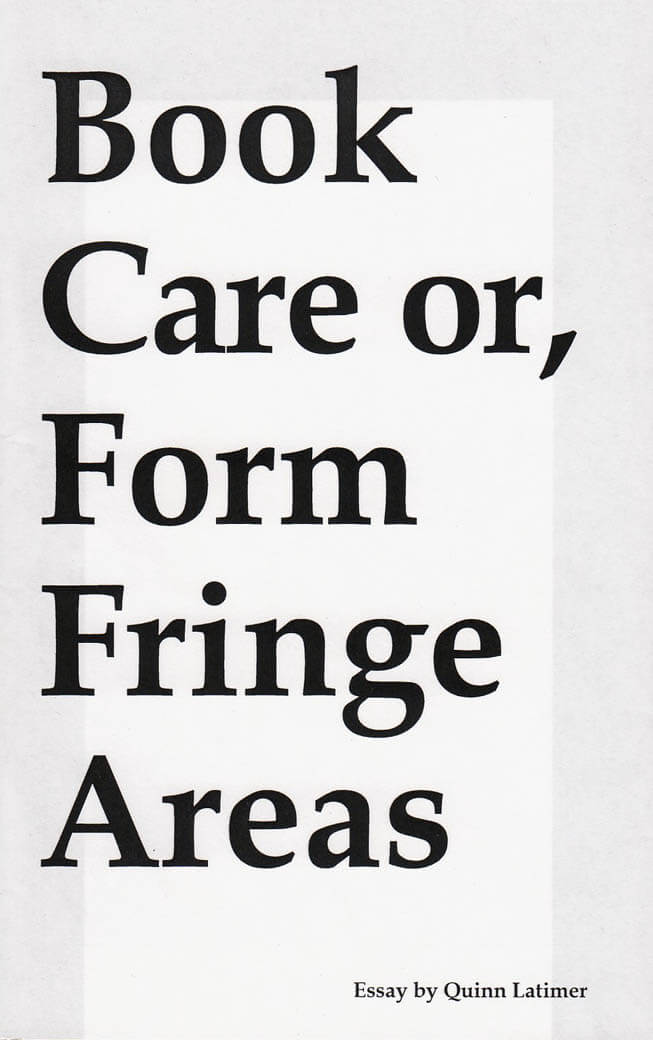
Best Book Don't Care Or, Poor Form From Fringe Areas
An essay on the forms or purposes of writing, books and libraries. Or as Quinn Latimer wrote: 'There is a relatively well-known workshop at Werkplaats Typografie, the school for design in Arnhem, Netherlands, called 'Best Books'. This past year the school asked the artist Sophie Nys to lead this course. In due time, Nys wrote König and asked if she might bring her students from the workshop to Cologne to discuss his work with books in the space of his own bookstore. She added that since he likely didn’t have enough chairs for all of her students, they would bring their own. König agreed. Then she asked her students to each pick their favorite book. They did so. Then she asked these students to design a chair inspired by that volume. An inspired idea. Strange—and useful. Thus 16 pieces of furniture suggested and elliptically inspired by specific books were built, a kind of living library of booklike creations, as another Walter might put it. The students went to see Herr König, stools in hand, their library entering his. I heard from Sophie in our email correspondence and singular Skype conversation that it was a wonderful visit. I even saw some pictures from that day. After the students returned to Arnhem, and for the final part of the project, they decided to make a publication. This is where I—and the text you are reading now—enter the picture, as they say.'

O Fortuna
In 2015, Jacob finds himself wandering the streets, swamps and cemeteries of New Orleans. Through his search for a man named Ignatius, 'O Fortuna' tells the story of his attempt to make a film. We discover the city’s unique atmosphere and meet a bizarre cast of characters who assist Jacob with his uncertain attempts at shooting scenes of DAT LIKWID LAND.
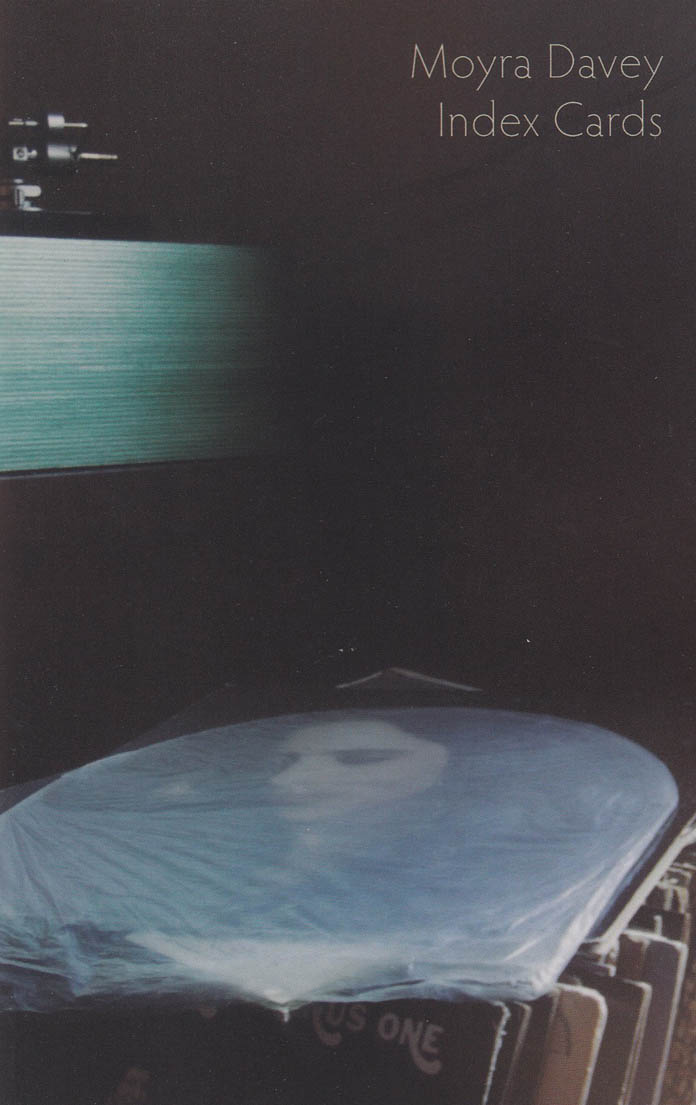
Index Cards: Selected Essays
In these essays, the acclaimed artist, photographer, writer, and filmmaker Moyra Davey often begins with a daily encounter, with a photograph, a memory, or a passage from a book, and links that subject to others, drawing fascinating and unlikely connections, until you can almost feel the texture of her thinking.
While thinking and writing, she weaves together disparate writers and artists, Mary Wollstonecraft, Jean Genet, Virginia Woolf, Janet Malcolm, Chantal Akerman, and Roland Barthes, among many others, in a way that is both elliptical and direct, clearheaded and personal, prismatic and self-examining, layering narratives to reveal the thorny but nourishing relationship between art and life.
Published May 2020.

What The Fire Sees
A collection of anti-capitalist poetry, philosophy, cultural analysis, legal studies, manifesto and critique spanning 1996 to the present by Alenka Zupančič, Alexander Kluge, Amy Ireland, Anne Boyer, Aurelia Guo, Bini Adamczak, Carolyn Lazard, Chi Chi Shi, Denis Ekpo, Feminist Judgments Project, Gili Tal, Houria Bouteldja, Huw Lemmey, Keziah Craven, Marina Vishmidt, Nat Raha, Sarah Lamble, Teflon and Vanessa Place.
Divided we fall, but where do we land? This collection explores some of the grounds on which thinking and writing can begin again.
– Sadie Plant

Letters to Jill
The reprint of Pati Hill's 1979 book, composed of images and texts by Hill through which she intended to contextualize and explain her working methodology to Jill Kornblee, her New York gallerist.
Published on occasion of Pati Hill's first posthumous solo exhibition at Kunstverein München in 2020.
Pati Hill (1921, Ashland, Kentucky – 2014, Sens, France) left behind an artistic output spanning roughly 60 years and encompassing various disciplines. Untrained as an artist, she began to use the photocopier as an artistic tool in the early 1970s and continued to do so until her death, leaving behind an extensive oeuvre that explores the relationship between image and text. In addition to this comprehensive body of xerographic work, she published four novels, a memoir, several short stories, artists books, and poetry. Drawing also became an essential part of her practice.
By using the copier—a machine that was stereotypically linked to secretarial work and thus to feminized labor—to trace everyday objects such as a comb, a carefully folded pair of men's trousers, or a child's toy, Hill developed an artistic practice that programmatically translated invisible domestic labor into a visual and public language. Through her use of this reproductive apparatus, she created a model of artistic production that critically opposes the convention of individual expression as well as the supposed neutrality of technologically produced images.
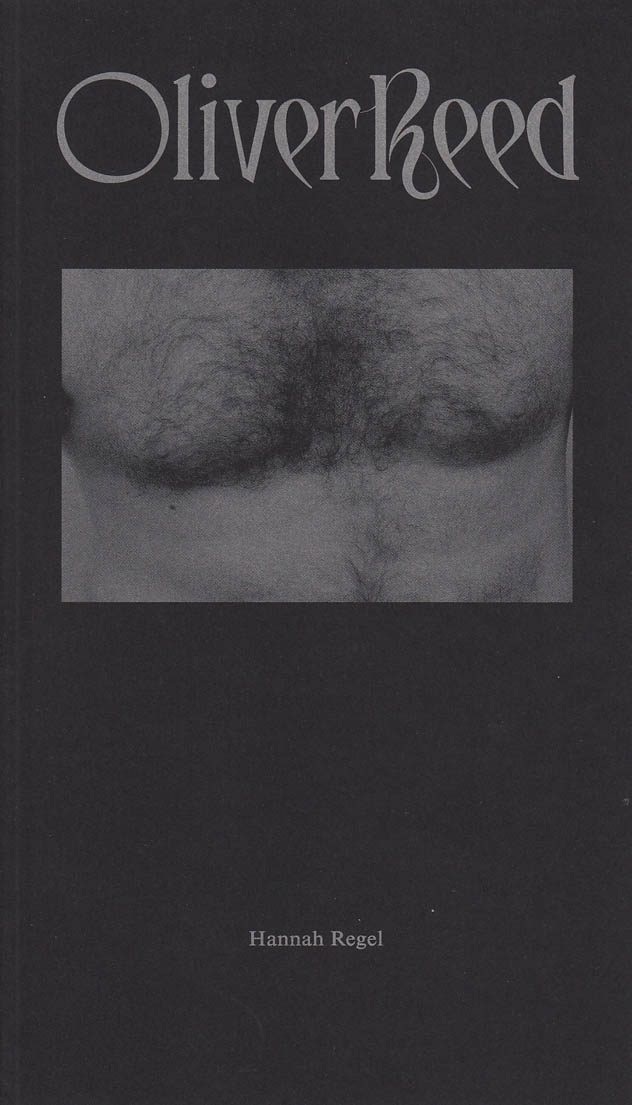
Oliver Reed
In Hannah Regel’s brilliant collection, Oliver Reed, the figure of the horse becomes an object for language’s brutality and the all too familiar subjugation of women’s voices, bodies, and labour. An impressive hyperbolic pastiche of pleasurable misbehavior guides a girl named Sorry through her own undoing while naming new tools for calculated resistance. ‘Kill the language. Kill it. Get the shovel. We’re making a belt.’ I would gladly do whatever she tells me to do and wouldn’t think of doing otherwise. Regel creates a new order for the ecstatic wreckage of obedience.
– Cassandra Troyan, author of Blacken Me Blacken Me, Growled
Regel doesn’t really sound like anyone. Oliver Reed introduces a poetic sensibility that seems as at odds with convention as it is equal to the moment: fully formed, virtuosic, kind of lethal. These are pitiless, discomforting poems that explore our own creatureliness with a deadly curiosity. Each is a transformation: the actor becomes a strange muse and guiding presence, to ‘smoulder a mobile furnace’; the horse, another of the book’s recurring figures, becomes more than an emblem of eros, labour and suffering; the young girl’s bratty insolence turns defiant and stricken. The voice wills these changes into being even as she ‘wills herself barren’. As much as they trouble and seduce, the poems are also watchful, vigilant – they seem to offer a means of protection. Oliver Reed is an astonishing, masterful first book.
– Sam Riviere, author of 81 Austerities

Ferrara Deux (Faits Divers)
faits divers are the various reports in a news bulletin, miscellaneous human interest stories, theorised by Roland Barthes as ‘total’ and ‘immanent’ information.
ferrara deux (faits divers) scrolls around the discovered corpse of a talented street musician named Landau, mangled and sealed into vacuum bags in the walk-in of a modern Italian-American restaurant. Street performance is content for an attention economy, playing on authenticities and profiting from recognition.
In this debut novel, artist Ivan Cheng reconfigures recent performance texts into an approximation of a murder mystery.
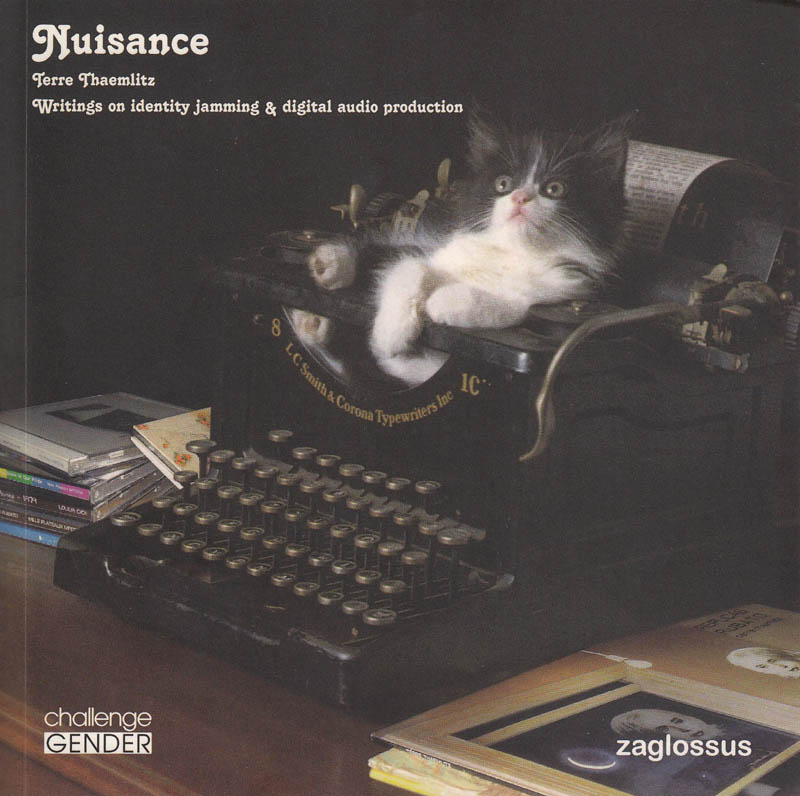
Nuisance
Nuisance compiles articles, essays, lecture transcripts, album annotations and other texts written by queer audio producer and writer Terre Thaemlitz between 1996 and 2015.
The overall theme uniting the texts is a defense of pessimism and a critical rejection of the incessant optimism lurking at the core of virtually all media – even in the “critical fields” themselves, where it reflects our conformity to those First World humanist and capitalist practices we wish to critique.

Parrhesiades Vol. 1
Parrhesiades is a multi-platform project, established in 2019 by curator Lynton Talbot to work with artists for whom language, either written spoken or otherwise performed is an essential part of their practice. Together with the artist, parrhesiades develops a single new work that exists across multiple platforms. With contributions by Quinn Latimer, Sung Tieu, Jesper List Thomsen, Elaine Cameron-Weir, Johanna Hedva, Eva Gold and Cally Spooner.
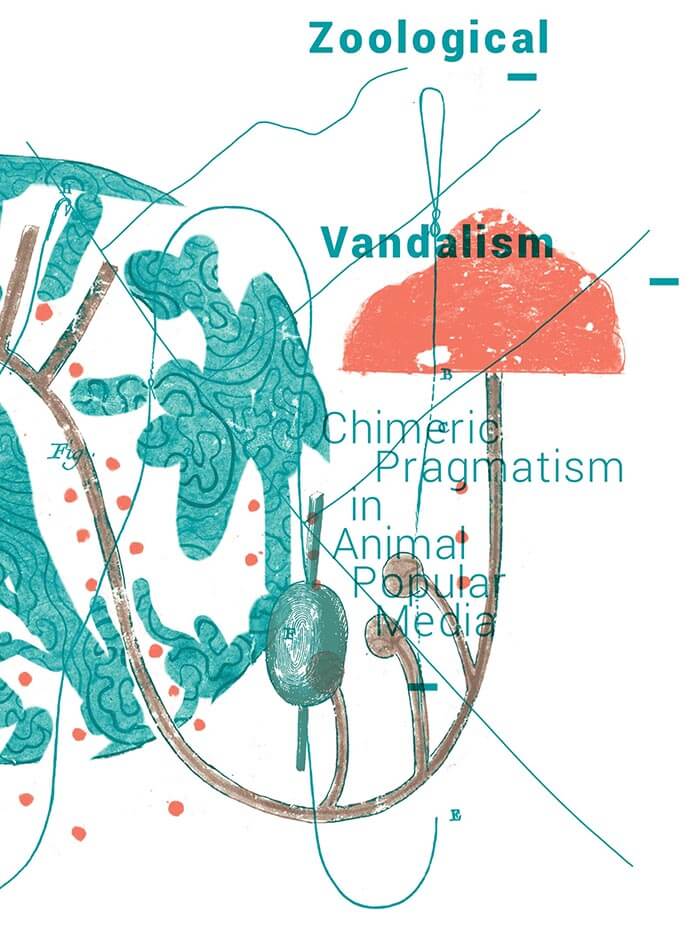
Zoological Vandalism
ZOOLOGICAL VANDALISM by Sina Seifee in collaboration with editor Renan Lauran and designer Foad Farahani, is immersion in the compiling and composing of Seifee’s notes on medieval bestiaries, and placing them in sequential order. It is the first chapter of a series that creates context and opens small descriptive steps towards (what Latour might call) “knowing interestingly” about bestiaries. It is a speculative adventure in bio-techno tales and old styles of knowing. As an “ecology of obligation” with Iranian sensuality and its ardent materiality, somewhere in the menagerie of found and feral animal videos on Whatsapp and Telegram, is Seifee’s undisciplined grounding in visual crafts.
Sina Seifee researches as an artist in the fields of narrative, performance, and knowledge production. He has been working on the question of technology and storytelling in the arts and sciences of the middle ages and the past-present of material reading practices in collective life. He studied Applied Mathematics in Tehran, received his MA in Media Arts in KHM Cologne. In 2017 he finished an advanced research program in performance studies in a.pass.

Beige Persuit
A character called X journeys through a present that is neither here nor there, but feels oddly proximate. She moves through landscapes of words, ever-shifting to host the groundless present, a place and time driven by her motivated, yet contextless pursuit. Narrative is always under construction. The preferred medium for X's peregrinations: a sentence, as capacious as a three-second video, a ten-year nap, or an unexplored hard drive. In this suspended world, X's sensorium is curious and alert, but also anguished, hesitant, and precarious: she feels around for sympathetic energies and familiar faces along the way. Along what way? A book like a body might be a room for waiting, a machine for memory, a sensuous thing, an image quickly glimpsed...
Working across a range of media including video, sound, performance, sculpture, collage, and installation, New York-based artist Sara Magenheimer disrupts, manipulates, and defamiliarizes language with bold combinations of image and text. Her videos incorporate traditional filmic editing techniques alongside those inspired by music and collage.
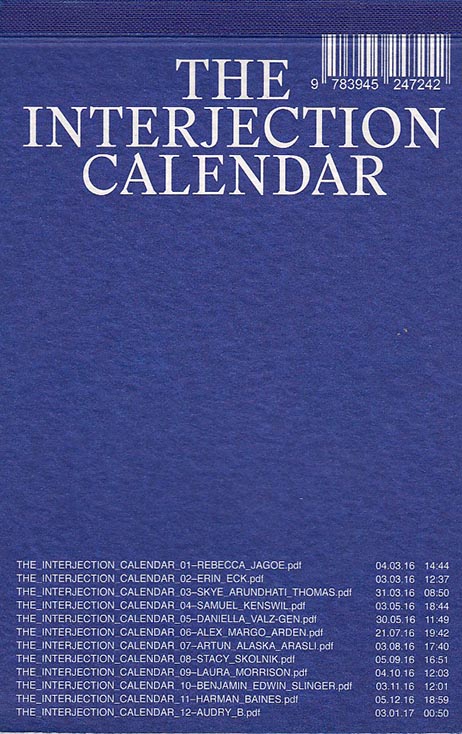
The Interjection Calendar 002
With contributions by: Rebecca Jagoe, Erin Eck, Skye Arundhati Thomas, Samuel Kenswil, Daniella Valz-Gen, Alex Margo Arden, Artun Alaska Arasli, Stacy Skolnik, Laura Morrison, Benjamin Edwin Slinger, Harman Bains and Audry B.
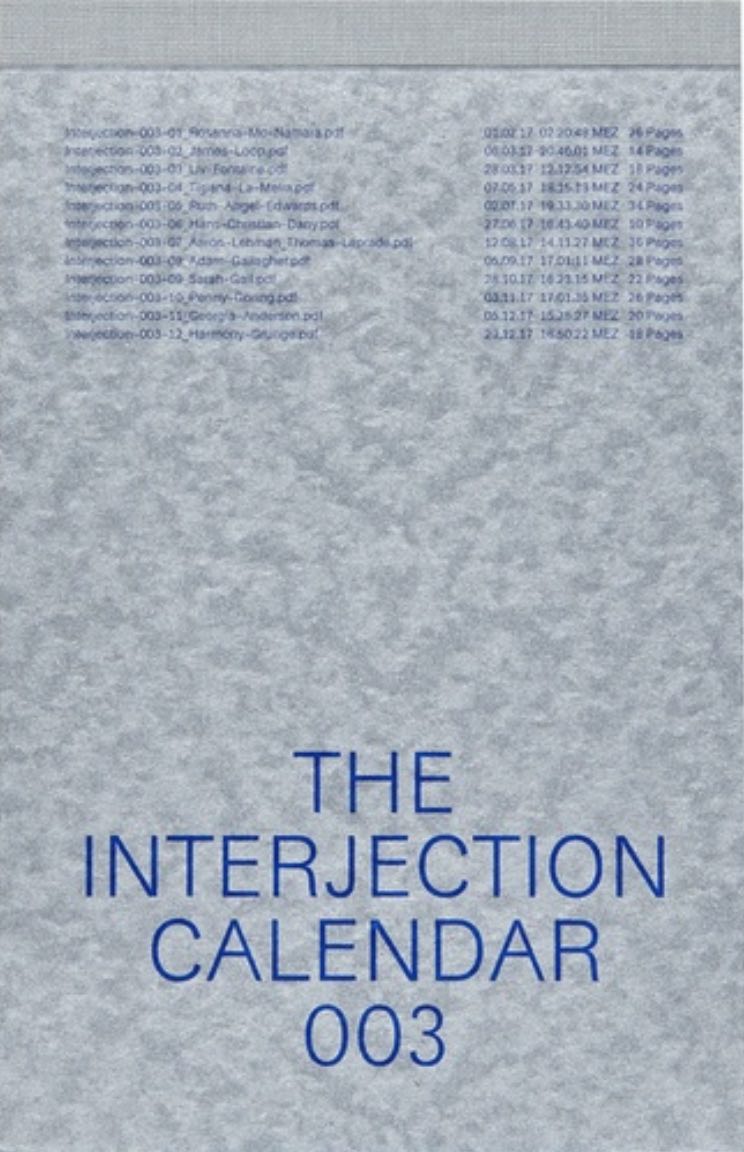
The Interjection Calendar 003
With contributions by: Georgia Patience Anderson, Hans-Christian Dany, Ruth Angel Edwards, Liv Fontaine, Sarah Gail, Adam Gallagher, Penny Goring, Harmony Grunge, Tiziana La Melia, Aaron Lehman and Thomas Laprade, James Loop, Rosanna McNamara.
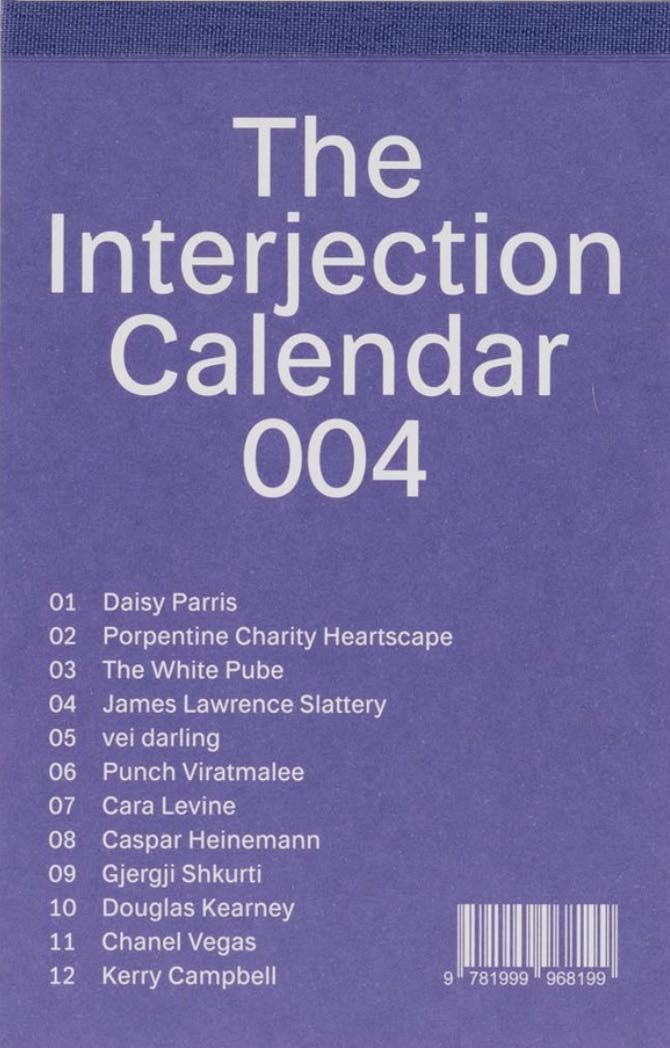
The Interjection Calendar 004
The Interjection Calendar is an on and offline project, devised and hosted by Montez Press. Each month an artist or writer is commissioned to produce a new piece of work for release on our website. The PDF can be downloaded for free and there are 12 releases per year. At the end of the year the collection is published, demonstrating a diverse range of collaborations and experimental works, mapping the year in contemporary art writing, with equal space held for the emerging and the established. The Calendar reflects the current importance of online content media, pushing the relationship between image and text in this domain.
Contributors: Kerry Campbell is a freelance curator and producer. She currently works as the Public Programmes Curator for Bloc Projects gallery (Sheffield) and is the founder and curator of TMT Projects - a contemporary arts platform based in Luton Town.
vei darling is a first generation Liberian-American multidisciplinary artist and activist, who grew up in the D(M)V. vei moved to New York City when she was 17, and began an intense path of spiritual reconfiguration. vei positions herself within social justice and humanitarianism, whilst being infused with magick and spirituality. Her ultimate desire is to subvert the current paradigm in lieu of one that respects and reflects life, love, and the pursuit of happiness.
Caspar Heinemann is a writer, artist and poet. Their interests include critical occultism, gay biosemiotics and countercultural mythologies. Some of the time they teach and read things at institutions, a lot of the time they cook potatoes in different shapes and listen to Alan Watts lectures. They were born in London, UK, roughly 2.5 months after the release of Green Day’s seminal album Dookie.
Douglas Kearney has published six books, most recently, Buck Studies (Fence Books, 2016), winner of the Theodore Roethke Memorial Poetry Prize, the CLMP Firecracker Award for Poetry and silver medalist for the California Book Award (Poetry). His work has been exhibited at the American Jazz Museum, Temple Contemporary, Los Angeles Contemporary Exhibitions, and The Visitor’s Welcome Center (Los Angeles). He studied at Howard University, Cave Canem, and California Institute of the Arts. Raised in Altadena, CA, he lives with his family just west of Minneapolis and teaches Creative Writing at the University of Minnesota–Twin Cities. Douglaskearney.com
Cara Levine - with: Khadija Tarver, Christine Wong Yap, Eliza Myrie, Greg Boyle, Rodney Lu- cas, Lukaza Branfman-Verissimo, Ashley Stull Meyers, Sidony O’neal, Kambui Olujimi Jadelynn Stahl, Amanda Eicher, Jessica Angima, Faye Gleisser, Quenton Baker, Sam Aranke, Jade Thacker, Ekaette Ekong, Christopher Johnson, Marvin K White, Kemi Adeyemi, Constance Hockaday, Kate Johnson, Bayete Ross-Smith, Leila Weefur, Kirat Randhawa, Angela Hennessy, Elizabeth Dorbad, Prophet Walker, Shamell Bell, Emilia Shaffer-Del Valle and Ann Lewis. Cara Levine lives in Los Angeles, CA and is an artist exploring the intersections of the physical, metaphysical, traumatic and illusionary through sculpture, video and socially engaged practice.
Daisy Parris was born in Kent, 1993, and graduated from Goldsmiths in 2014. She currently lives and works in South London. Daisy Parris’ work raises questions about identity politics as well as the limits of what it means to be human. By using various formats such as portraiture, roomscapes and text, Parris focuses on identity struggles as well as the worry, guilt, numbness and the violent encounters of everyday existence.
Porpentine Charity Heartscape is a writer, game designer, and dead swamp milf in Oakland. Her work includes xeno-femme sci /fantasy, cursed video games, and globe-spanning sentient slime molds. She has exhibited at the 2017 Whitney Biennial, EMP Museum, and the National Gallery of Denmark, and has been commissioned by Vice and Rhizome.
James Lawrence Slattery is an artist, critic and academic living and working in London. They hold an undergraduate degree in Fine Art from Goldsmiths, University of London and a masters in Film Aesthetics from St Anne’s College, University of Oxford.
Gjergji Shkurti is a New York based author. His writing explores architecture as fiction and incorporates a filmic imagination. The writing stems from a yearning to push history forward.
Chanel Vegas is an artist who works in London. She writes poetry, makes paintings, and regularly performs as part of her work. Chanel graduated from Goldsmiths in 2017 and was the first student to be the recipient of the university’s Artist Award.
Punch Viratmalee currently lives and works in Bangkok, Thailand. Viratmalee graduated Chulalongkorn University in 2015 with a BA in Communication Design. She previously worked at a commercial gallery in Bangkok and is now working as a curatorial assistant for the first Thailand Biennale. She also writes.
The White Pube is the collaborative identity of Zarina Muhammad and Gabrielle de la Puente under which they write criticism an occasionally curate. The White Pube is based at thewhitepube. com and on Twitter and Instagram as @thewhitepube.

Pfeil Magazine #9 – Error
The meaning of the word ‘error’, in its origin, is neutral. In Latin ‘errare’ means both ‘to wander freely’ and ‘to wander from the right path’. After the seventeenth century, however, the word ‘error’ lost its ambiguity within English usage and became clearly understood as wrongdoing, as defect, as a way of missing a desired effect. The ninth issue of Pfeil Magazine focuses on the potential of erroneous processes to redefine the meaning of malfunction and takes a look at movements that are aimless or non-productive. Through this reflection, ‘error’ is introduced once again as the possibility of wandering freely.
Contributions by: Mitchell Anderson, Christiane Blattmann, Adam Christensen, Tyler Coburn, Hans-Christian Dany, Michael Dean, Gina Fischli, Flaka Haliti, Laëtitia Badaut Haussmann, Lina Hermsdorf, Judith Hopf, Karl Larsson, Clare Molloy, Susan Morgan and Thomas Lawson, Mense Reents, Stacy Skolnik, Paul Spengemann, Ramaya Tegegne
Editors: Anja Dietmann, Nadine Droste

Pfeil Magazine #10 – Mainstream
Within the format of a magazine, each page of Pfeil represents the floor, walls, or ceiling which together create an imagined room displaying a printed exhibition. Each issue is dedicated to a specific word, and artists are invited and given space to work on and with this term, and to construct or deconstruct the architecture around it. Combined, the contributions transform into an organic display surrounding the leitmotif.
The tenth issue is dedicated to Mainstream, this volume questions exercised motions of majorities, practiced over long or short distances and timeframes, that can become patterns, sometimes taken for granted, sometimes followed unconsciously, automatically, or even mechanically.
Contributions by: Alice Creischer, Annette Kelm, Charlotte Simon, Dodo Voelkel, Emily Pope, Hans-Christian Dany, Harry Gamboa Jr., Heike-Karin Föll, Holly White, Jan Matthé, Jannis Marwitz, Karl Holmqvist, Kevin Gallagher, Lars Bang Larsen, Magdalena Los, Marina Pinsky, Merle Radtke, Nicola Gördes, Pablo Schlumberger, Penny Goring and Stella Rossié.
Editor: Anja Dietmann

Sirens
‘Masturbation in between the crimes against you will become a deciding matter in the kangaroo court. Philosophical questions will be answered without inquiry.’
If you have ever wondered how a cross between a funding application gone wrong and a tabloid column about the art world would read, this is it. Mellor presents a unique combination of novel and image, creating a polymorphous narrator who moves between personifications. Perhaps the most hazardous of these is Tippy Rampage, who is satisfyingly livid with the state of, well, everything.
In a series of paintings, female police officers from British television shows such as Happy Valley and The Bill are positioned in an array of apocalyptic settings: freezing, burning, and backdropped by flooding. The accompanying text chronicles an acute feeling of being watched, what it feels like to watch whoever is watching you, or, as Mellor writes, how it feels to be kettled in your own flat, by your own paintings.
Fragmented accounts map the protagonist’s shifting relationship to crime, gender, class and sexuality from multiple perspectives: as a child in Gamesley in the ‘70s, a lesbian performer in sex clubs in the mid ‘90s, an artist with and without gallery representation, and as a lecturer within an academic institution. These changes of position mix the language of a rally cry with an acerbic satire of the authorial voice and everyone they encounter.
Published by Montez Press, Sirens is the first novel by Dawn Mellor and includes the complete set of the Sirens paintings.
Dawn Mellor (b.1970) is an artist based in London, who has been exhibiting internationally since the 1990s. Solo exhibitions and special projects include Sixty Years at Tate Britain; London, Vile Affections at Studio Voltaire; London, Dawn Mellor at The Migros Museum; Zurich, Sirens at Team Gallery; New York, Madame X and The Party Tricks at Victoria Miro; London, Michael Jackson On The Wall at The National Portrait Gallery; London (touring), What Happened to Helen? Focal Point Gallery; Southend and Malerei, Böse at Kunstverein; Hamburg.

Pfeil Magazine #11 – Love
The eleventh issue of Pfeil Magazine looks into the multitude of meanings behind the word love: a positive affection and strong physical feeling which can be addressed to a friend, family, food, God, an object, or to an amorous partner or partners. Furthermore, it questions the expectations which go along with love, whether that love is returned or unanswered. Relationship patterns and role distributions are surveyed, vulnerabilities are assessed, but besides that the Love issue is also about a pregnant male seahorse, an infatuation with a smiling rock, sports and much more.
Contributors: Adrian Williams, Anneli Schütz, CAConrad, Ceyenne Doroshow, Cyd Nova, Dan Kwon, Emily Pope, Eva Illouz, FORT, Gerrit Frohne-Brinkmann, Gina Fischli, Hanna Fiegenbaum, Hans-Christian Dany, Keenan Jay, Maria Jakobsen, Mette Sterre, Monika Baer, Nick Oberthaler, Lindsay Lawson, Stine Sampers, Suné Woods, Theodore Barrow, Thomas Laprade, Vanessa Place and Vincent Ramos.

The Interjection Calendar 005
Emily Pope, Christiane Blattmann
For the Interjection Calendar each month Montez Press invites an artist, a writer, a poet or a doer of some sorts to say things. All 12 pieces have introspection and reflection in common. They are a subjective overview of writing in the expanded field of contemporary art and writing in the year 2019. This is the Interjection Calendar 2019, the fifth collection in this series.
With contributions by sabrina soyer, Lisa Robertson, Hatty Nestor, Adrianna Whittingham, Sondria, Claudia Pagès, Laetitia Paviani, Bella Milroy, Georgina Tyson, Son Kit, Alix Jean Vollum, Rene Matic and bleubaglife.
Find the last 12 PDF's on montezpress.com.

Wimper
Alex Farrar’s book Wimper (the Dutch term for eyelash, or a potential misspelling of the English for ‘whimper’) presently held by the reader is an extension of an exhibition, which may be experienced in its own right, after the space has been vacated. It operates on the limits of material evidence by reprising a series of earlier prints entitled Behavioural Residues (second sweep), featuring barely perceptible images of single eyelashes spread throughout the texts and pages. Apart from their significance as intimate materials discarded by the body over time, such as hair or skin, they submit to the almost nothing of an aesthetics of disappearance, while lingering in a dialectics of misunderstanding that commits to a lack of closure.
Texts by Nicolas de Oliveira and Nicola Oxley, and David Price. Graphic design by studio Hendriksen, risograph printed by Alex Farrar in studio Hendriksen, Amsterdam, with the cover offset printed by ZwaanLenoirSchuring and bound by AGIA (The Netherlands) in a print run of 300 copies.

The Hundreds
Kathleen Stewart, Laurent Berlant
In The Hundreds Lauren Berlant and Kathleen Stewart speculate on writing, affect, politics, and attention to processes of world-making.
The experiment of the one hundred word constraint, each piece is one hundred or multiples of one hundred words long, amplifies the resonance of things that are happening in atmospheres, rhythms of encounter, and scenes that shift the social and conceptual ground.
What's an encounter with anything once it's seen as an incitement to composition? What's a concept or a theory if they're no longer seen as a truth effect, but a training in absorption, attention, and framing?
The Hundreds includes four indexes in which Andrew Causey, Susan Lepselter, Fred Moten, and Stephen Muecke each respond with their own compositional, conceptual, and formal staging of the worlds of the book.
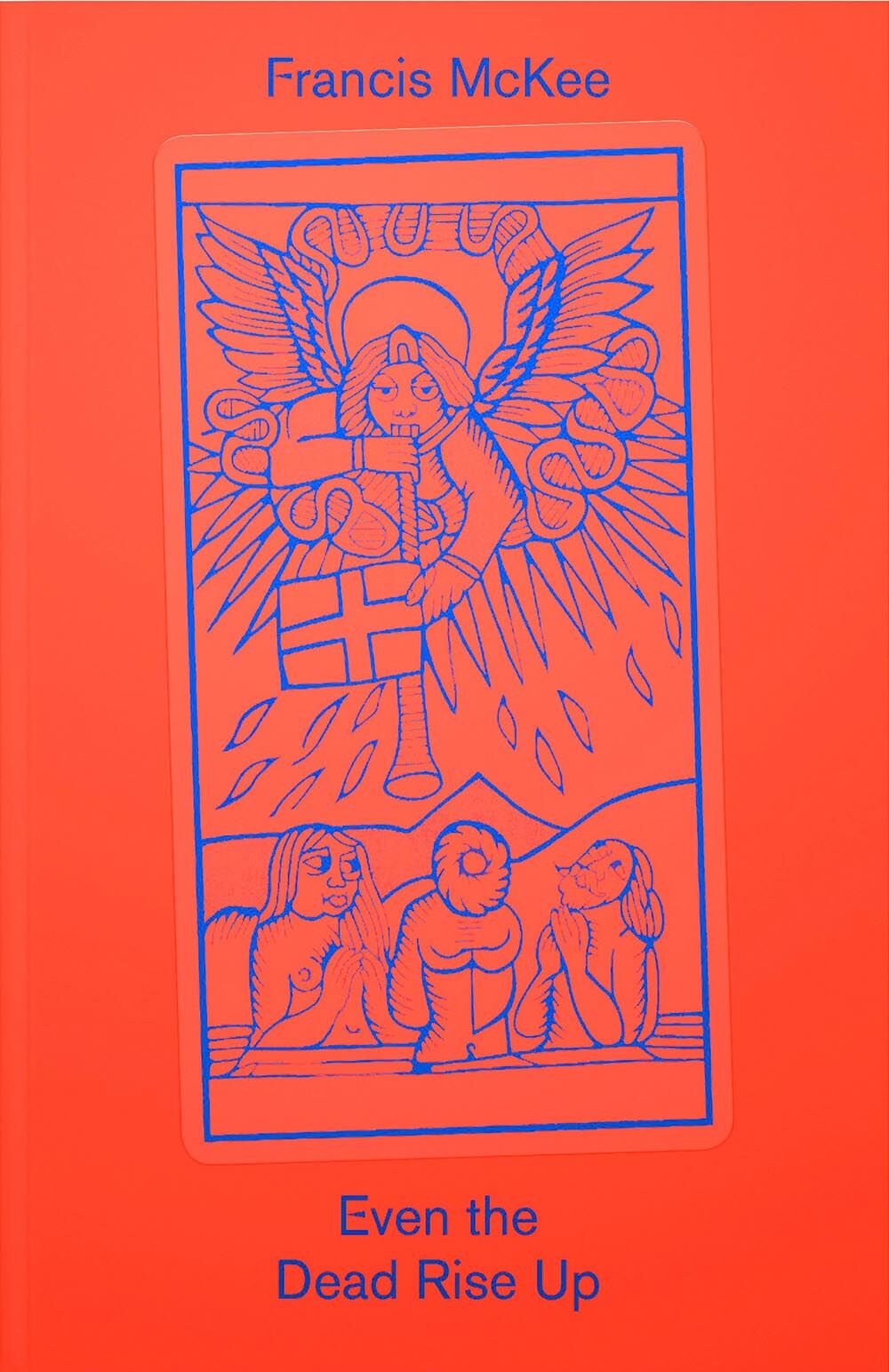
Even The Dead Rise Up
Even the Dead Rise Up, and the political becomes personal. In McKee’s first novel, observations of séances, scientific advances, group education outings, Kurdish protests for the ‘disappeared’, become mixed with his own Tarot influenced visions: a haunting spirit appears; the relation between political resistance and Spiritualism is cast as an insurrectionary force and a millenarian energy, celebrating the ecstatic moment. Histories of isolated early Christians and twentieth century mystics affect the psyche, all of this documented through journal entries that move from Scottish islands to Puerto Rico. Influenced by forms of 1960s new journalism, McKee pushes language to match the raw material of the stories, which become more erratic, signalling the looming fate of the text and its author.